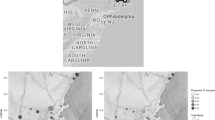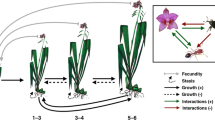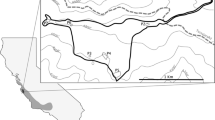Abstract
There is considerable interest in understanding how invasive species disperse across landscapes, and how they affect resident species. However, quantifying these processes using mark recapture or manipulative experiments can be time consuming and costly. A different approach is to study density changes across a broader landscape, and take advantage of naturally existing replicate locations that are imperfect, but plentiful. We documented sites of recent colonization and measured density changes in the invasive gecko Hemidactylus mabouia and the prior resident gecko Hemidactylus garnotii in Florida. We surveyed geckos at 398 locations from 19 regional sites distributed across central and southern Florida. We documented changes in abundance through repeated censuses of 56 locations in areas of sympatry between 2001 and 2009. Complete displacement occurred in <7 years at several locations, and overall there was a >10% increase in H. mabouia per year. There was evidence that H. mabouia reaches a higher carrying capacity than H. garnotii, which likely contributes to its competitive dominance. Changes in relative abundance within patches were consistent with a density dependent mechanism of displacement, suggesting the decline of H. garnotii is functionally linked to increases in H. mabouia abundance, which allows us to rule out coincidental factors not directly associated with H. mabouia. However, simulations showed that even highly asymmetric differences in carrying capacity and competitive ability were not sufficient to account for the rapid displacement we observed. We conclude that mechanisms other than resource competition must be at work to drive species displacement in this system.





Similar content being viewed by others
References
Agrawal AA, Ackerly DD, Adler F, Arnold AE, Caceres C, Doak DF, Post E, Hudson PJ, Maron J, Mooney KA, Power M, Schemske D, Stachowicz J, Strauss S, Turner MG, Werner E (2007) Filling key gaps in population and community ecology. Front Ecol Environ 5:145–152
Bohn T, Amundsen P, Sparrow A (2008) Competitive exclusion after invasion? Biol Invasions 10:359–368
Butterfield BP, Hauge B, Meshaka WE (1993) The occurrence of Hemidactylus mabouia on the United States mainland. Herpetol Rev 24:111–112
Byers JE (2000) Competition between two estuarine snails: implications for invasions of exotic species. Ecology 81:1225–1239
Byers JE, Goldwasser L (2001) Exposing the mechanism and timing of impact of nonindigenous species on native species. Ecology 82:1330–1343
Case TJ, Bolger DT, Petren K (1994) Invasions and competitive displacement among house geckos in the tropical Pacific. Ecology 75:464–477
Cheng X, Xie P, Cheng F, Xu R, Xie B (2009) Competitive displacement of the native species Bursaphelenchus mucronatus by an alien species Bursaphelenchus xylophilus (Nematoda: Aphelenchida: Aphelenchoididae): a case of successful invasion. Biol Invasions 11:205–213
Clavero M, Garcia-Berthou E (2005) Invasive species are a leading cause of animal extinctions. Trends Ecol Evol 20:110
Dame EA, Petren K (2006) Behavioural mechanisms of invasion and displacement in Pacific island geckos (Hemidactylus). Anim Behav 71:1165–1173
Diamond J (1986) Overview: laboratory experiments, field experiments, and natural experiments. In: Diamond J, Case T (eds) Community ecology. Harper and Row, New York
Dick JTA, Montgomery WI, Elwood RW (1999) Intraguild predation may explain an amphipod replacement: evidence from laboratory populations. J Zool Lond 249:463–468
Ekesi S, Billah MK, Nderitu PW, Lux SA, Rwomushana I (2009) Evidence for competitive displacement of Ceratitis cosyra by the invasive fruit fly Bactrocera invadens (Diptera: Tephritidae) on mango and mechanisms contributing to the displacement. J Econ Entomol 102:981–991
Eubanks MD, Blackwell SA, Parrish CJ, Delamar ZD, Hull-Sanders H (2002) Intraguild predation of beneficial arthropods by red imported fire ants in cotton. Environ Entomol 31:1168–1174
Frankenberg E (1982) Social-behavior of the parthenogenetic Indo-Pacific Gecko, Hemidactylus-Garnotii. Zeitschrift Fur Tierpsychologie—J Comp Ethol 59:19–28
Gerber GP, Echternacht AC (2000) Evidence for asymmetrical intraguild predation between native and introduced Anolis lizards. Oecologia 124:599–607
Grosholz ED, Ruiz GM, Dean CA, Shirley KA, Maron JL, Connors PG (2000) The impacts of a nonindigenous marine predator in a California bay. Ecology 81:1206–1224
Holway DA (1999) Competitive mechanisms underlying the displacement of native ants by the invasive Argentine ant. Ecology 80:238–251
Jeschke JM, Strayer DL (2006) Determinants of vertebrate invasion success in Europe and North America. Glob Change Biol 12:1608–1619
Juliano SA (1998) Species introduction and replacement among mosquitoes: Interspecific resource competition or apparent competition? Ecology 79:255–268
Kaplan L, Kendell D, Robertson D, Livdahl T, Khatchikian C (2010) Aedes aegypti and Aedes albopictus in Bermuda: extinction, invasion, invasion and extinction. Biol Invasions 12:3277–3288
King W, Krakauer T (1966) The exotic herpetofauna of southeast Florida. Q J Fla Acad Sci 29:144–154
Kuno E (1992) Competitive exclusion through reproductive interference. Res Popul Ecol 34:275–284
Lohrer AM, Whitlatch RB (2002) Interactions among aliens: apparent replacement of one exotic species by another. Ecology 83:719–732
MacNeil C, Dick JT, Johnson MP (2004) A species invasion mediated through habitat structure, intraguild predation, and parasitism. Limnol Oceanogr 49:1848–1856
Maynard Smith J (1978) The Evolution of Sex. Cambridge University Press, Cambridge
McKinney ML (2006) Urbanization as a major cause of biotic homogenization. Biological Conserv 127:247–260
McKinney ML, Lockwood JL (1999) Biotic homogenization: a few winners replacing many losers in the next mass extinction. Trends Ecol Evol 14:450–453
Meshaka WE (1995) Reproductive cycle and colonization ability of the Mediterranean gecko (Hemidactylus turcicus) in south-central Florida. Fla Sci 58:10–15
Meshaka WE (2000) Colonization dynamics of two exotic geckos (Hemidactylus garnotii and H. mabouia) in Everglades National Park. J Herpetol 34:163–168
Meshaka WE, Butterfield BP, Hauge JB (2004) The exotic amphibians and reptiles of Florida. Krieger Publishing Company, Melbourne
Meshaka WE, Ferster B, Meshaka ML, Meshaka ML (2008) Exotic species dominance in the herpetofaunal community of a new residential development in southern Florida: implications for faunal turnover rates. Fla Sci 71:65–75
Moyer GR, Osborne M, Turner TF (2005) Genetic and ecological dynamics of species replacement in an arid-land river system. Mol Ecol 14:1263–1273
Murphy-Walker S (1990) Sperm storage in female Hemidactylus frenatus lizards family gekkonidae. Am Zool 30:77
Paini DR, Funderburk JE, Reitz SR (2008) Competitive exclusion of a worldwide invasive pest by a native. Quantifying competition between two phytophagous insects on two host plant species. J Animal Ecol 77:184–190
Parker IM, Simberloff D, Lonsdale WM, Goodwell K, Wonham M, Kareiva PM, Williamson MH, Von Holle B, Moyle PB, Byers JE, Goldwasser L (1999) Impact: toward a framework for understanding the ecological effects of invaders. Biol Invasions 1:3–19
Petren K, Case TJ (1996) An experimental demonstration of exploitation competition in an ongoing invasion. Ecology 77:118–132
Petren K, Case TJ (1998) Habitat structure determines competition intensity and invasion success in gecko lizards. Proc Natl Acad Sci USA 95:11739–11744
Petren K, Bolger DT, Case TJ (1993) Mechanisms in the competitive success of an invading sexual gecko over an asexual native. Science 259:354–358
Porter SD, Savignano DA (1990) Invasion of polygyne fire ants decimates native ants and disrupts arthropod community. Ecology 71:2095–2106
Prenter J, MacNeil C, Dick JT, Dunn AM (2004) Roles of parasites in animal invasions. Trends Ecol Evol 19:385–390
Punzo F (2001) A comparative study of digestive function in three species of Hemidactyline geckos from Florida. Fla Sci 64:124–130
Punzo F (2005) The introduction of hemidactyline geckos in Florida: colonization and impact on native fauna. In: Meshaka WE Jr, Babbitt KJ (eds) Amphibians, reptiles: status, conservation in Florida. Krieger Publishing Company, Malabar, pp 231–237
Regaldo R (2003) Roles of visual, acoustic, and chemical signals in social interactions of the tropical house Gecko (Hemidactylus mabouia). Caribb J Sci 39:307–320
Rehage JS, Barnett BK, Sih A (2005) Foraging behaviour and invasiveness: do invasive Gambusia exhibit higher feeding rates and broader diets than their noninvasive relatives? Ecol Freshw Fish 14:352–360
Ricciardi A, Whoriskey FG (2004) Exotic species replacement: shifting dominance of dreissenid mussels in the Soulanges Canal, upper St. Lawrence River, Canada. J North Am Benthol Soc 23:507–514
Ricciardi A, Neves RJ, Rasmussen JB (1998) Impending extinctions of North American freshwater mussels (Unionoida) following the zebra mussel (Dreissena polymorpha) invasion. J Anim Ecol 67:613–619
Rilov G, Benayahi Y, Gasith A (2004) Prolonged lag in population outbreak of an invasive mussel: a shifting-habitat model. Biol Invasions 6:347–364
Settle WH, Wilson LT (1990) Invasion by the variegated leafhopper and biotic interactions: parasitism, competition, and apparent competition. Ecology 71:1461–1470
Shine RL, Schwartzkopf L (1992) The evolution of reproductive effort in lizards and snakes. Evolution 46:62–75
Short KH, Petren K (2008) Boldness underlies foraging success of invasive Lepidodactylus lugubris geckos in the human landscape. Anim Behav 76:429–437
Short KH, Petren K (2011a) Fine-scale genetic structure arises during range expansion of an invasive gecko. PLoS One 6(10):e26258. doi:10.1371/journal.pone.0026258
Short KH, Petren K (2011b) Multimodal dispersal during the range expansion of the tropical house gecko Hemidactylus mabouia. Ecol Evol 1(2):181–190. doi:10.1002/ece3.18
Silvertown J (2009) A new dawn for citizen science. Trends Ecol Evol 24:467–471
Snyder WE, Clevenger GM, Eigenbrode SD (2004) Intraguild predation and successful invasion by introduced ladybird beetles. Oecologia 140:559–565
Tompkins DM, White AR, Boots M (2003) Ecological replacement of native red squirrels by invasive greys driven by disease. Ecol Lett 6:189–196
Townsend JH, Krysko KL (2003) The distribution of Hemidactylus (sauria: gekkonidae) in northern peninsular Florida. Fla Sci 66:204–208
Tsutsui ND, Suarez AV, Holway DA, Case TJ (2000) Reduced genetic variation and the success of an invasive species. Proc Natl Acad Sci USA 97:5948–5953
Wiles GJ, Bart J, Beck RE, Aguon CF (2003) Impacts of the brown tree snake: Patterns of decline and species persistence in Guam’s avifauna. Conserv Biol 17:1350–1360
Wilson JRU, Dormontt EE, Prentis PJ, Lowe AJ and Richardson DM (2009) Something in the way you move: dispersal pathways affect invasion success. Trends Ecol Evol 24(3). doi:10.1016/j.tree.2008.10.0007
Zamprogno C, Teixeira RL (1998) Food habits of the tropical house gecko Hemidactylus mabouia (Reptilia, Gekkonidae) from a sandy coastal plain of Espirito Santo, Eastern Brazil. Revista Brasileira De Zoologia 58:143–150
Acknowledgments
The authors wish to thank Liz Dame, Ashley Allemang, John Niedzwiecki, Ninnia Lescano, Andrew Clack, Jeff Olberding, and Phoebe Richgels for help with field censuses in Florida. We also thank Gisela Garcia-Ramos, Stephen Matter, Eric Maurer, Michal Polak, George Uetz and two anonymous reviewers for helpful comments and suggestions. Funding was provided by the University Research Council and the Weiman Wendel Benedict Fund.
Author information
Authors and Affiliations
Corresponding author
Rights and permissions
About this article
Cite this article
Short, K.H., Petren, K. Rapid species displacement during the invasion of Florida by the tropical house gecko Hemidactylus mabouia . Biol Invasions 14, 1177–1186 (2012). https://doi.org/10.1007/s10530-011-0147-z
Received:
Accepted:
Published:
Issue Date:
DOI: https://doi.org/10.1007/s10530-011-0147-z




